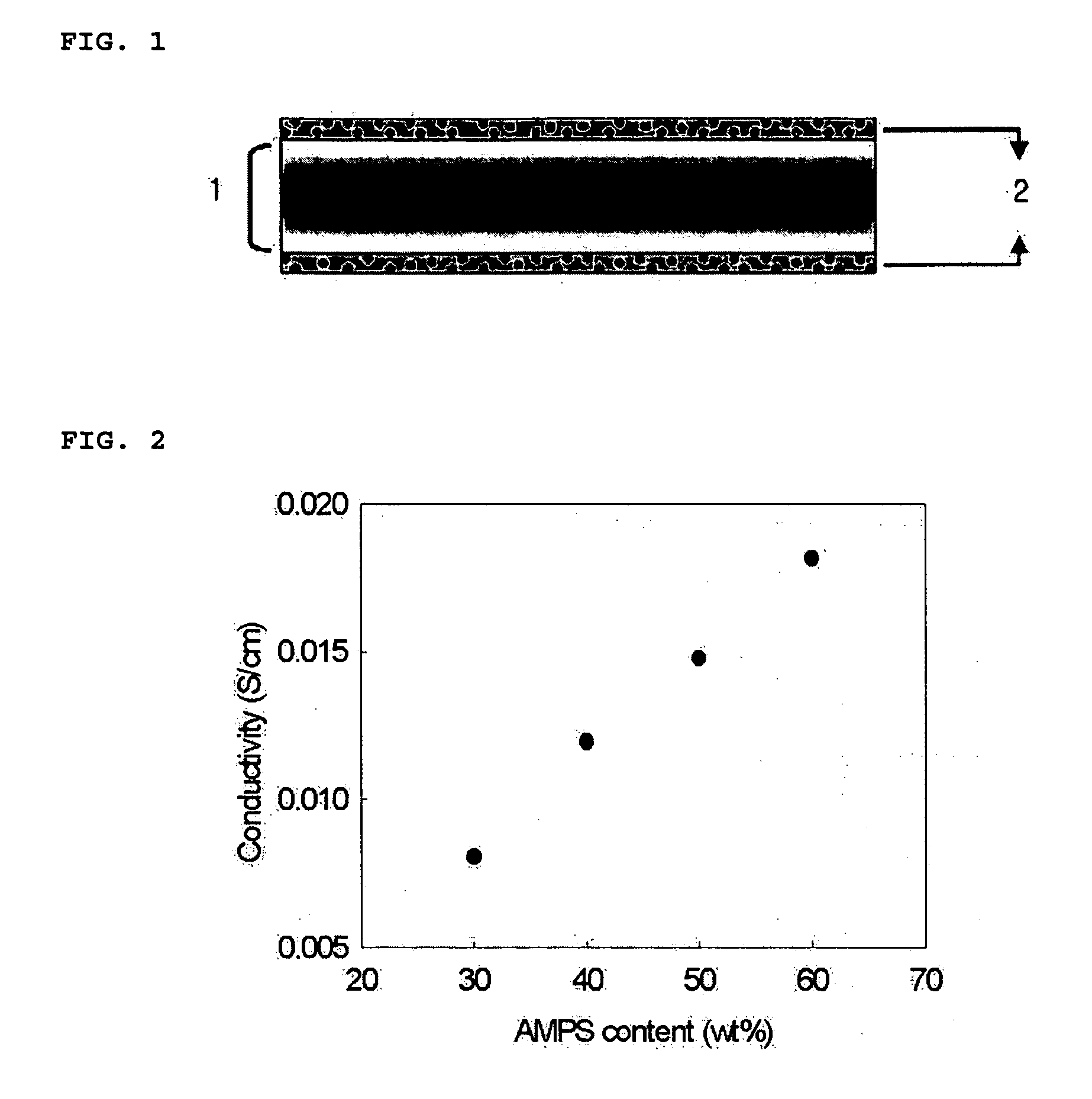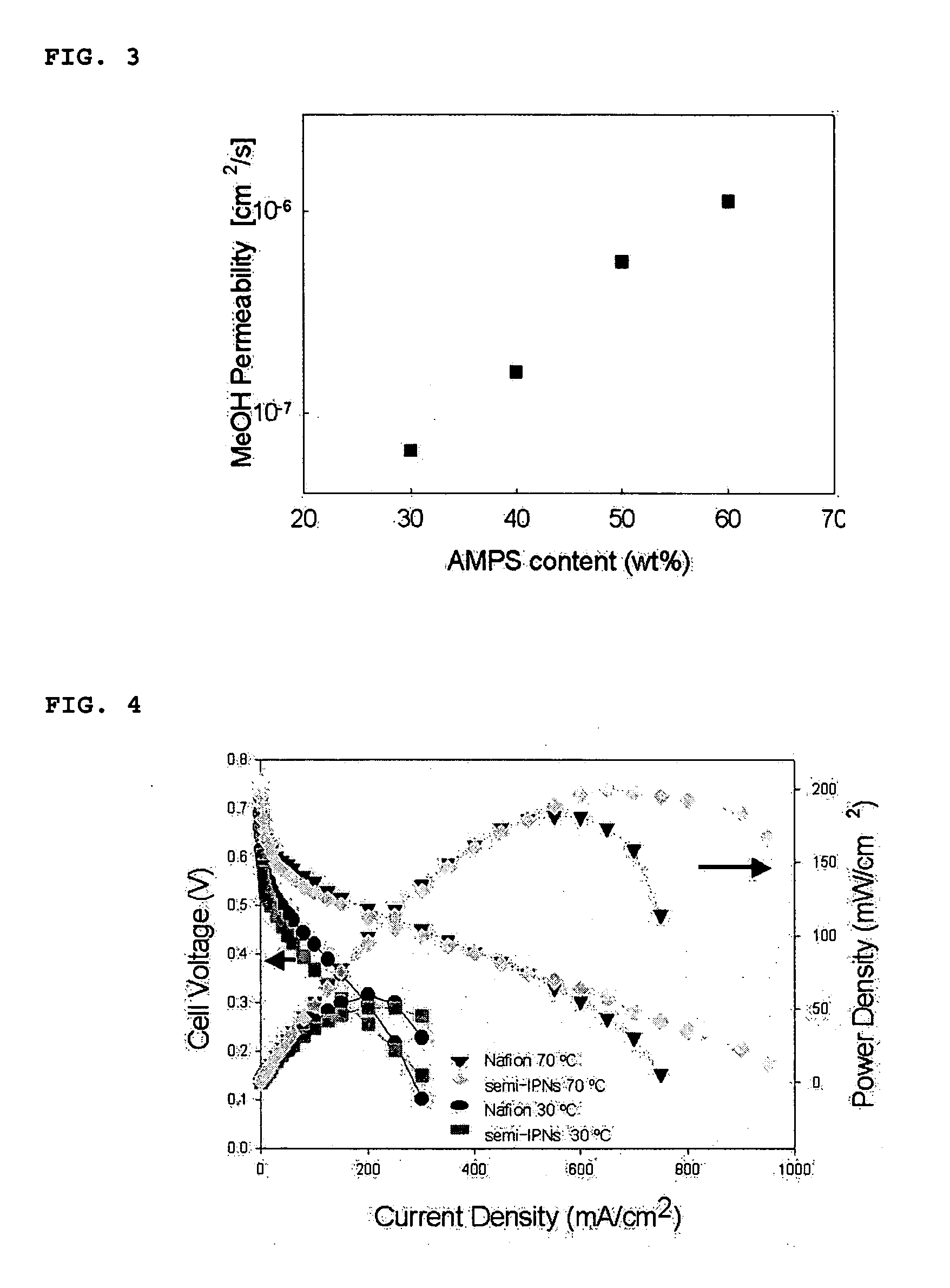Polymer electrolyte composition for direct methanol fuel cell with suppressed methanol crossover
a technology of methanol crossover and polymer electrolyte, which is applied in the direction of non-aqueous electrolyte cells, sustainable manufacturing/processing, and final product manufacturing, etc., can solve the problems of deteriorating fuel cell performance, waste of fuel, and most significant limitation of dmfcs commercialization, so as to improve the proton conductivity, improve the mechanical properties, and minimize the effect of methanol crossover
- Summary
- Abstract
- Description
- Claims
- Application Information
AI Technical Summary
Benefits of technology
Problems solved by technology
Method used
Image
Examples
example 1
[0029] A Nafion® 112 membrane (DuPont) was pretreated in H2O2 for 2 hours, in 1M H2SO4 for 2 hours, and in H2O for 2 hours to remove impurities present on the membrane surface. The pretreatment was carried out at 80° C. The pretreated membrane was impregnated in a solution containing 0.6 g of 2-acrylamido-2-methyl-1-propanesulfonic acid (AMPS), 0.2 g of 1,6-hexanediol ethoxylate diacrylate (HEDA), and 0.4 g of 2-ethylhexyl acrylate (EHA) dissolved in 40 mL of dimethylformamide (DMF), and then 0.002 g of benzophenone as a photopolymerization initiator was added thereto. 2-Ethylhexyl acrylate (EHA) was then added to improve flexibility. The mixture was subjected to a photocrosslinking reaction at room temperature for 10 minutes to fabricate a membrane. The resistance of the membrane was measured using an FRA (Frequency Response Analyzer) and the proton conductivity was calculated from the measured values. The results are shown in FIG. 2. Further, the methanol permeability of the membr...
example 2
[0030] Polymer electrolyte membranes were fabricated as described in Example 1, except that commercially available Nafion® 115 and Nafion® 117 polymer membranes having different thicknesses were used instead of the Nafion® 112 membrane. The cell performance of the polymer electrolyte membranes was measured, and the results are shown in FIG. 4. FIG. 4 confirmed that the maximum power density values of the electrolyte membranes were 200 mW / cm2, whereas those of the commercially available Nafion® membranes were 180 mW / cm2. Thus, the cell performance of the electrolyte membranes was improved by 11%, compared to the commercially available membranes.
example 3
[0031] Polymer electrolyte membranes were fabricated as described in Example 1, except that Flemion® (Asahi Glass) and Aciplex® (Asahi Chemical) were used as the perfluorinated ionomers. The proton conductivity was similar to that of Example 1.
PUM
| Property | Measurement | Unit |
|---|---|---|
| humidity | aaaaa | aaaaa |
| weight | aaaaa | aaaaa |
| mechanical properties | aaaaa | aaaaa |
Abstract
Description
Claims
Application Information
 Login to View More
Login to View More - R&D
- Intellectual Property
- Life Sciences
- Materials
- Tech Scout
- Unparalleled Data Quality
- Higher Quality Content
- 60% Fewer Hallucinations
Browse by: Latest US Patents, China's latest patents, Technical Efficacy Thesaurus, Application Domain, Technology Topic, Popular Technical Reports.
© 2025 PatSnap. All rights reserved.Legal|Privacy policy|Modern Slavery Act Transparency Statement|Sitemap|About US| Contact US: help@patsnap.com


